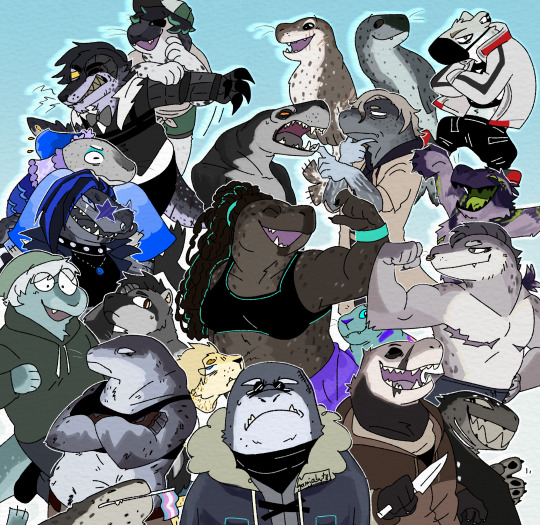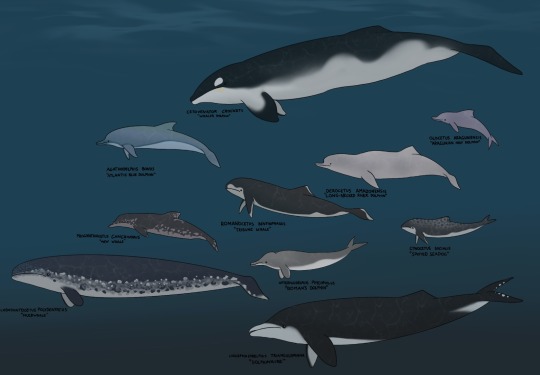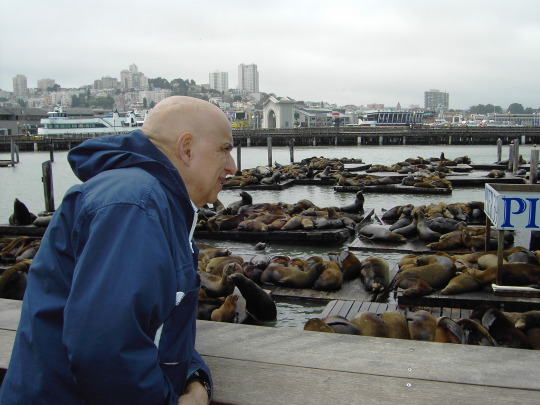#pinniped(s)
Explore tagged Tumblr posts
Text

Walruses By: Joseph S. Rychetnik From: The Desert 1977
104 notes
·
View notes
Text


ARTFIGHT MASS ATTACKS!
Last year I randomly decided to try drawing all the leopard seal OCs on artfight, so these were a continuation of those. Mass attacks are definitely more fun and efficient than drawing them all singularly!
The seal with sunglasses in the bottom-middle of both images is my Arknights doctor OC, Riptide, who is my own leopard seal OC :)
People in these attacks that are on tumblr include: @odetoscavengers, @crovoroh, @fishsplash, @matoitech, @captain-maws, @oddtaxiyaoi, @bioluminescent-bat, @thereminzone, @blazingbaboon, @soul-of-sin, @styllwaters, @rhincodon-cynocephalus, @werewolveswithagenda, @lemurking-doodles, and @messbianarts!
Thanks for all the sharp teeth and chubby necks!!
#leopard seal#pinnipeds#artfight#af 2023#gbart#arknights oc#gbsocs#that is a disaster of @s#also i juts got tumblrs new post maker. itsa wful#why are so many leopard seal ocs transmasc LOL>????#half the @s died but ITS OK SOB EMOJI
73 notes
·
View notes
Text
I went to the zoo today and (among other things) saw flamingos (alas, his Lordship must have been in a secret tunnel, for they were all brightly colored), The Great God Om, and Dr. Horace Worblehat The Librarian.
I got a number of weird looks for cooing over various venomous reptiles and going “Aren’t you a sweetie? You’re so handsome!” in a babyish voice, but on the other hand I started singing a Gaelic song about the sea and two seals turned to look at me at the same time, which (to quote a certain angel who sauntered vaguely downwards) “was a thing”. Also: I saw an echidna (woo monotremes!), three sand cats (baby! Even if it’s an adult it’s a baby), and got to pet some rays and a ball python. All in all, I’d say it was a good day (except the heat and crowds).
#discworld#gnu terry pratchett#vetinari#havelock vetinari#lord vetinari#om#the gods#the librarian#seal(s)#pinniped(s)#gaeilge#gaelic#language#selkie#good omens#neil gaiman#crowley#reptile(s)#echidna#monotreme#sand cat#stingray#animals#snake#thought(s) from yours truly#zoo
90 notes
·
View notes
Note
hello, big pinniped fan here! i understand your thoughts on how mammals don't belong in the splatoon world, but what about pinnipeds? seeing as stuff like birds and insects are still around.
i will say, i do hate the manatee bit from marina in splatoon 2, because i imagine that if pinnipeds do exist, they probably didnt evolve too much. stuff like ducks still act the same, i cant imagine a seal deciding to walk around and order a cheeseburger from mcdonalds. (squiddonalds?)
pinnipeds are mammals, my thoughts are the same: it does not matter if it seems plausible for it to have survived somehow, all mammals are extinct and that is a core part of splatoon's setting. if any mammals were casually just. alive. aside from grizz and the 2 cats (which. still bugs me that the judds were conveniently omitted from rotm), then that just ruins the whole premise of splatoon 3's main story mode lol
39 notes
·
View notes
Text
It’s possible the Snowmads, who are said to hail from the North Sea, are originally from the Snow Kingdom.
Shiverians and the Snowmads both have snowflake emblems, Scandinavian-inspired architecture and are themselves based on large pinnipeds, such as seals and walruses.

Source(s):
The Art of Super Mario Odyssey
The Art of Super Mario Odyssey
33 notes
·
View notes
Text

The open oceans of the future would vastly resemble those of today, with similar groups dominating the seas. The biggest and most dominant animals are the cetaceans, descended from two single surviving species: the Commerson’s dolphin and the Guyana dolphin.
Some of the biggest dolphins are the macropredatory Cetovenatoridae, and some enormous bottom feeders, like the muckwhale. Other effective predators are the deep hunting tribune whales, the pod hunting spotted seadogs, and the school targeting Atlantic blue dolphins.

Since seals and other pinnipeds went completely extinct at the end of the Holocene their niche will be filled by the Phutroidea superfamily ( https://www.reddit.com/r/SpeculativeEvolution/s/ljdSwyAmat ), descended from marine otters.
Pelagic fish niches remained mostly unchanged, with most sharks, rays and teleost taxa surviving the mass extinction.

In the Anectyocene oceans, tho, there’s also new additions: a group of ancestrally oceanic platypuses, with a handful of secundarily freshwater Asian and South Pacific species, that feed on invertebrates on the seafloor; and sea sloths descended from three-toed sloths, converging on Thalassocnus’s lifestyle, pulling themselves across the seafloor grazing seaweed, and becoming the biggest sloths since the Quaternary.
#spec evo#spec bio#speculative evolution#speculative biology#artwork#digital art#epigene period#future earth
25 notes
·
View notes
Text


It comes a day in every pinniped(troll)'s life when they get the GPS tracker...

13 notes
·
View notes
Note
hi. today i deliver unto you my favorite animal The leopard seal (Hydrurga leptonyx), also referred to as the sea leopard, is the second largest species of seal in the Antarctic (after the southern elephant seal). Its only natural predator is the orca. It feeds on a wide range of prey including cephalopods, other pinnipeds, krill, fish, and birds, particularly penguins. It is the only species in the genus Hydrurga. Its closest relatives are the Ross seal, the crabeater seal and the Weddell seal, which together are known as the tribe of Lobodontini seals. The name hydrurga means "water worker" and leptonyx is the Greek for "thin-clawed". Leopard seals are pagophilic ("ice-loving") seals, which primarily inhabit the Antarctic pack ice between 50˚S and 80˚S. Sightings of vagrant leopard seals have been recorded on the coasts of Australia, New Zealand (where individuals have been seen even on the foreshores of major cities such as Auckland, Dunedin and Wellington), South America, and South Africa. In August 2018, an individual was sighted at Geraldton, on the west coast of Australia. Higher densities of leopard seals are seen in the Western Antarctic than in other regions. The only natural predator of leopard seals is the orca. The seal's canine teeth are up to 2.5 cm (1 in) long. It feeds on a wide variety of creatures. Young leopard seals usually eat mostly krill, squid and fish. Adult seals probably switch from krill to more substantial prey, including king, Adélie, rockhopper, gentoo, emperor and chinstrap penguins, and less frequently, Weddell, crabeater, Ross, and young southern elephant seals. Leopard seals are also known to take fur seal pups.

DELIGHTFUL!!!!!!!!
18 notes
·
View notes
Text

average turbot debate (they are debating which pinniped is on S tier btw)



#paw patrol#turbot tales au#darryl h. turbot#cap'n turbot#francois turbot#artists on tumblr#ares' art
4 notes
·
View notes
Note
What’s your favorite sea creature(s)? I personally like jellyfish and pinnipeds (seals and sea lions)!
"Hm... Have you ever seen a manatee? They're kind of weird-looking, but they're so docile that some predators don't even want to hunt them anymore."
13 notes
·
View notes
Note
7, 13, 24?
7. what animal do you look forward to seeing when you visit an aquarium?
I just answered this but since I said sea otters and most aquariums Don't have those, I really love getting to see the jellyfish, any sharks, rays, anemones, and touch pool stuff. AND SEALS AND SEA LIONS AND OTHER PINNIPEDS! But also just everything in general really
13. first thing you’re doing in the purge?
Hmmmmmm. Okay so personally I don't think I'd murder anyone because I'm against it morally, I can't stomach it, also I don't think I physically could. Tbh I believe in the best of people and I don't think most people are gonna do heinous shit. So I'd probably just focus on self defense/protection and stay home. I'd hoard a bunch of stuff like downloads of movies and games. I'd try a safer illegal drug maybe? But honestly I think the real danger is that everyone will suspect that other people will do bad stuff, so they do bad stuff (this is just like Danganronpa)
But I really can't imagine myself doing that much. Hopefully motivate other people to take political action towards things that are maybe not always legal?
24. which do you find yourself using, american or british english?
USAmerican English since I am USAmerican! I've lived here my whole life and never left. But for some reason I use British spelling for a lot of random words. Like, I write grey and not gray and archaeology and not archeology. I also sometimes use British or European terms for things that I've picked up on from friends or learned before I learned the US version. A lot of how I write and talk has weird influences because I learned things from books and television rather than other people. But I definitely have distinct vocabulary and ways of speaking that place me to very specific places in the USA. I think the only British-ism I refuse to do is use "realise" and "apologise" or any other -s word like that rather than "realize" or "apologize". This is because I say it with enough of a z sound that I think I should write it.
2 notes
·
View notes
Text
AP News 5/3/24
"SAN FRANCISCO (AP) — They’re lounging, biting each other and generally making a ruckus in numbers not seen in more than a decade. And don’t even think about stealing their anchovies.
San Francisco’s famed Fisherman’s Wharf district is seeing a surge in sea lions.
First appearing at Pier 39 after the 1989 earthquake, the sea lions have become a well known tourist attraction. The number of sea lions — marine mammals that make loud barking calls and can weight up to a half-ton — crashing at the pier fluctuates over the seasons. On most days more than a hundred can be seen.
But this week, Pier 39 harbormaster Sheila Chandor has counted more than 1,000 sea lions, and that’s the most seen there in 15 years. A huge school of anchovies — a favored food of the pinnipeds — brought them there, Chandor said...."
and "it's Spring" she said
1 note
·
View note
Text
Aldemaro Romero Jr.'s Letters from Academia #39. Sea lions and earthquakes.

Aldemaro Romero Jr.'s Letters from Academia # 39. Sea Lions and earthquakes. A few California sea lions (Zalophus californianus) began "hauling out" on Pier 39's after the Loma Prieta earthquake hit San Francisco in October 1989. By January 1990, these pinnipeds started to arrive in droves. With a plentiful supply of food from the Bay and an environment protected from white sharks and orcas, the Pier 39 Marina proved to be an ideal living situation for the sea lions. The number of sea lions grew to more than 1,700 in November 2009. Unfortunately, numbers are going down because of local plastics pollution. Every time I go to San Francisco, I visit them.
0 notes
Photo

Some sketchy doodles of Skipper! ⛵
#Rubberhose#Skipper#cartoon#toony#sea lion#seal#pinniped#sketch#doodle#original character#1930's cartoon#cuphead#vintage cartoon#sailor
39 notes
·
View notes
Note
Hello! I found your blog and now expect seal facts everyday in your askbox, now heres one for ya:
Seals Are Related to Bears, Skunks, and Badgers
Evolutionary biologists have been arguing over seals' origins for more than a century. While relatively sure that pinnipeds evolved from land-dwelling carnivores, scientists are divided on the precise steps that occurred between terrestrial ancestors and modern marine mammals. Along with the three subclades of pinniped, the suborder Caniformia contains Ursidae (bears), Mustelidae (badgers, otters, weasels, and relatives), and Mephitidae (skunks and stink badgers). In 2007, a nearly complete skeleton of a new semi-aquatic carnivore from an early Miocene lake deposit in Nunavut, Canada, was discovered and became known as an evolutionary link between land mammals and seals.
woah- 😳 bro,, this is cute ( because- s e a l s ) and interesting at the same time 😂😭
#nectar's rambling#anon message#♡ anon#seal anon <3#hii sunshine!#i actually gasped bcs i never expected messages like this#but they're adorable#and yes u mfs who destroy magic moments 😤#i do know it's copy paste#but still adorable 😌#because no one ever wanted to teach me about seals 😠✨#🎀 anon
5 notes
·
View notes
Text
The Early Temperocene: 125 million years post-establishment
Kept At Bay: Bayvers of the Early Temperocene
Bayvers, aquatic pinniped-like marine hamsters, first arose in the Early Therocene from beaver-like ancestors, being semi-aquatic beach dwellers akin to the seals of Earth. And while many species still live today in such amphibious coastal niches, many of the bayvers have since moved on to a fully-aquatic life: most notably the cricetaceans, but also a few other stem-cricetacean groups that independently abandoned the land as well.
The Temperocene is a time of shallow, productive seas, teeming with a diversity of life far beyond that of the Glaciocene. While warm seas are less supportive of upwellings that favored the growth of truly immense giants, the rising sea levels mean plenty of shallow seas conducive to the growth of marine plants, kelp and algae: which in turn support countless other species that directly or indirectly depend on these plants for food.

Among the most common of the bayvers as of the Early Temperocene are the herbivorous hamatees: bayvers that specialized on a diet of aquatic vegetation, and have thus now flourished as the sea became conducive to a boom of water plants and fast-growing kelp. The East Arcuterran hamatee (Dugocricetus arcuterrus) in particular would thrive in the semi-submerged beachpeach forests that grew in shallow seas, where they supplement their diet of seagrass with the fruits and seeds of beachpeach that fall into the water and float on the surface, drifting across the sea and providing a feast for many opportunistic aquatic frugivores.
With so many plants in the sea to choose from, such as beachpeach trees, floating coast kudzu, marine undergrass, kelp, seaweed and algae, herbivorous bayvers have diversified like never before. Small, round-bodied hamatees known as the walmus (Sirenodobenus spp.) are one of the most divergent, with several species in this one genus already radiated to a wide range of habitats, such as the coastal walmus (S. pilosus) foraging at the equatorial sea floor and using its whiskers to sense for anything edible, but in particular undergrass rhizomes, and the peninsular walmus (S. peninsulaustrus) feeding on surface algae and kelp in colder seas further south.
But one of the more remarkable groups are the whaleruses (Balaenodobenus spp.), a group that have taken up residence out in the open sea. Here, they skim the surface to feed on the abundant floating algae: but also facultatively filter-feed on marine plankton with the aid of their bristly whiskers. In essence, they are filling the niche the giant seavers once did, at a smaller, less-specialized scale, with the Glaciocene giants now gone, a victim of the age of the harmster.

Many cricetaceans, however, have made it past the Glaciocene, especially smaller ones that were too numerous and too difficult to catch, for the harmsters to wipe out entirely. In particular, those outside of the Centralic Ocean fared better, as few harmsters ever explored and plundered those domains, leaving the small cricetaceans a fighting chance their greater cousins never had.
Primarily, it was the intelligent roddolphs (family Delphinocetomuridae) that could better figure out how to escape the strange new land predator, that persisted beyond the surface hunters' extinction. Their cousins the porpoids (family Marinodelphimuridae) would also persist due to their wide ranges and adaptable diets which aided their survival in an age of overhunting in big enough populations to rebound. They would occupy the niches the small cricetaceans ancestrally had, as small-scale predators of shrish, pescopods and skwoids that live in abundance in the open pelagic seas.
With their resurgence in the Temperocene their large predatory relative, the phorca (family Phobodelphimuridae) would also thrive once again: and even more so than before, with their major competitors the leviahams and plurodons out of the way. Different species would specialize upon different prey, depending on size, migration and regional availability, some going after large shrish and skwoids, and others preying on other marine hamsters. The ones that do hunt smaller cricetaceans notably have begun relying more on cutting incisors rather than multi-cusped molars: slowly reverting back to a more traditionally rodent-like dentition with large slicing incisors: but ones used for a very novel niche, as marine apex predator.

And thus recently would diversify one of the strangest lineages of the bayver family: the tusked jousting bayvers. This clade narrowly escaped harmster extermination as one single species that lived far too north for the harmsters to pursue. Perhaps as a response to increased phorca predation, this clade would develop more robust tusks that were used mostly for stirring up the seafloor when foraging, but can also make for a lethal ramming weapon if need be.
The tusk, formed from the right upper incisor, grows forward and straight, emerging through the split upper lip, while the left upper incisor grows inward, to grind evenly with both lower incisors: thus still retaining the chewing rodent motion while repurposing one misaligned tooth as a tusk. Some species, such as the polar warnal (Cerodontocetomys borealis) are primarily peaceful foragers, using their tusks mostly for digging up shellfish from the sea floor or using them as clubs to stun small shrish and pescopods to make them easier to swallow. But other species, such as the white-banded seamrai (Gladioceratodon katanae), are much more aggressive, especially the males: who routinely use their narrow, upward-curved tusks for territorial displays, which, while rare, sometimes erupts into an easily-lethal jabbing match.
But probably the most notable member of the bayver family as a whole is a strange, rugose-skinned species found only off the coasts of southern Gestaltia, a creature whose spotted, wrinkled hide and long white whiskers give the impression of an ancient old survivor indeed: the derelict seaver (Geriatrobalenomys relicus). Barely six feet long and weighing about a ton, this stunted creature is the last of the seavers: once the greatest of creatures to swim the seas, routinely reaching 18 meters or more, now the derelict seaver is all that remains of the once-gigantic lineage. Its remote location and smaller size made it less of a target for the harmsters, and, in a warmer sea with fewer plankton upwellings and more hamatee competition, this relatively-tiny remnant, feeding on shoals of zooplankton and small shrish, is content to remain in a size a mere fraction of what its immense ancestors once were.
▪▪▪▪▪▪▪▪▪
49 notes
·
View notes